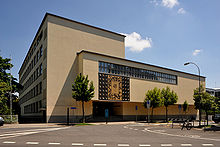- Natural History Museum of Bern
-
The Natural History Museum of Bern (German: Naturhistorisches Museum der Burgergemeinde Bern) is a museum in Bern, Switzerland. In its teaching and research it cooperates closely with the University of Bern.[1] It is visited by around 100,000 people yearly.
Contents
History
The museum is owned by the Bürgergemeinde of Bern. It was officially founded in 1832. It is located on Bernastrasse, in the Kirchenfeld quarter, in a building that was erected between 1932 and 1934, opened in 1936 and expanded several times since then. Previously the exhibits were kept in a building on Hodlerstrasse built from 1878-81 and demolished in 1936; and earlier still, in the library gallery of a former college building.
Collection
The museum is known for its set of over 220 life-sized dioramas, featuring preserved animals from Switzerland, Africa and Asia; it also owns a collection of minerals from the Alpine region, samples of gold discovered at various locations in Switzerland, meteorites, a large stock of invertebrates,[1] and Switzerland's largest collection of animal skeletons and bones.
Stuffed animals
The dioramas originate from a collection of big game animals from Africa, bagged by the London-based Bernese painter and game hunter Bernhard von Wattenwyl (together with his daughter Vivienne) during an expedition in 1923-24.[1] A total of 130 of these animals are on display, in 33 dioramas along two darkened corridors. The dioramas are designed and furnished according to the animals' natural habitat.
There is a further section displaying native birds and mammals, with over 600 animals in 164 dioramas. This section was previously on display in the Heimatmuseum, opened around the outbreak of World War II.
The upper basement contains five dioramas of Asian animals threatened with extinction: snow leopards, orangutans, giant pandas, Indian rhinoceroses, and tigers.
A fourth section called "Nordic Animals" features stuffed bears, muskoxen, seals, moose and birds, in nine dioramas containing 66 individual animals.
One of the museum's biggest attractions is the stuffed hide of Barry the St. Bernard, who is said to have saved the lives of over 40 people. A special exhibit dedicated to him was held in 2001.[2][3] [4]
Other exhibits
The largest collection of animal skeletons and bones in Switzerland is displayed under the name "The Big Bone Show" (Die grosse Knochenschau).[5] This room exhibits over 300 skeletons, including those of a fin whale and an Asian Elephant. Eight of the larger skeletons sit upon a continually revolving carousel. The display cabinets contain numerous further exhibits, including 518 individual bones.
The Albert Heim Foundation for the promotion of cynological research is based at the museum, and possesses the world's largest collection of canine skulls.[6]
External links
Notes
- ^ a b c In Bern beliebt - auf der ganzen Welt beachtet (German)
- ^ "The Legendary Barry at the Natural History Museum". Natural History Museum of Bern. http://www.nmbe.ch/deutsch/531_5_1_9.html. Retrieved March 20, 2011.
- ^ "Barry 200 years - a tribute to the nose". Natural History Museum of the Civic Community of Berne. 09/06/2000 - 02/25/2001. http://www.nmbe.ch/deutsch/221_5.html. Retrieved March 20, 2011.
- ^ Nussbaumer, Marc. Barry of the Great St. Bernard. pp. 92 and 77 illustrations CHF 24.
- ^ Die grosse Knochenschau Online magazine of the University of Bern, 31 May 2005. (German)
- ^ Albert-Heim-Stiftung - Aktuelles Albert Heim Foundation website. (German)
- This article incorporates information from this version of the equivalent article on the German Wikipedia.
Categories:- Museums in Bern
- Natural history museums
- Museums established in 1832
- 1832 establishments in Switzerland
Wikimedia Foundation. 2010.

